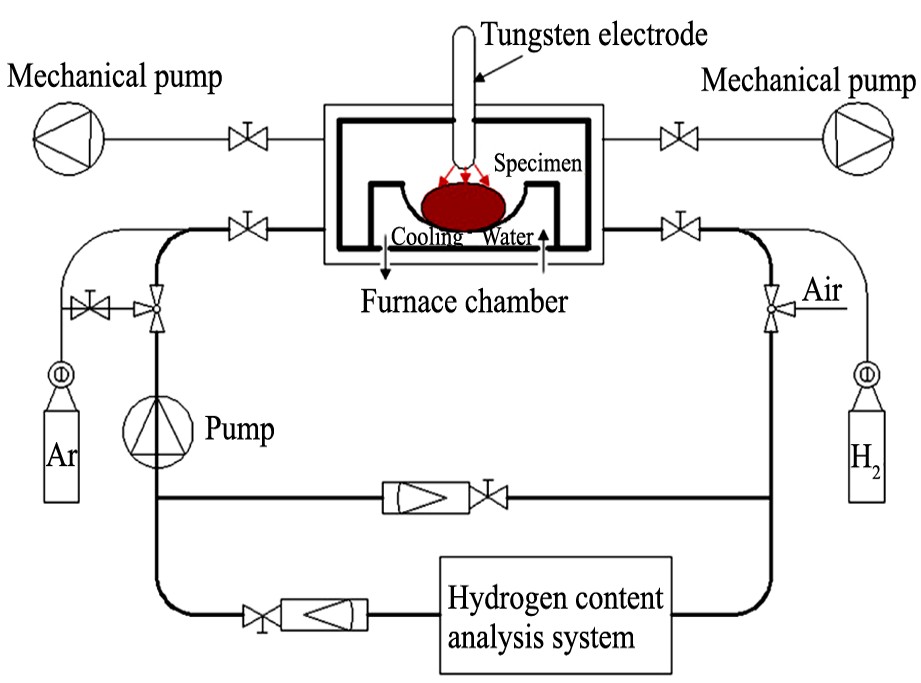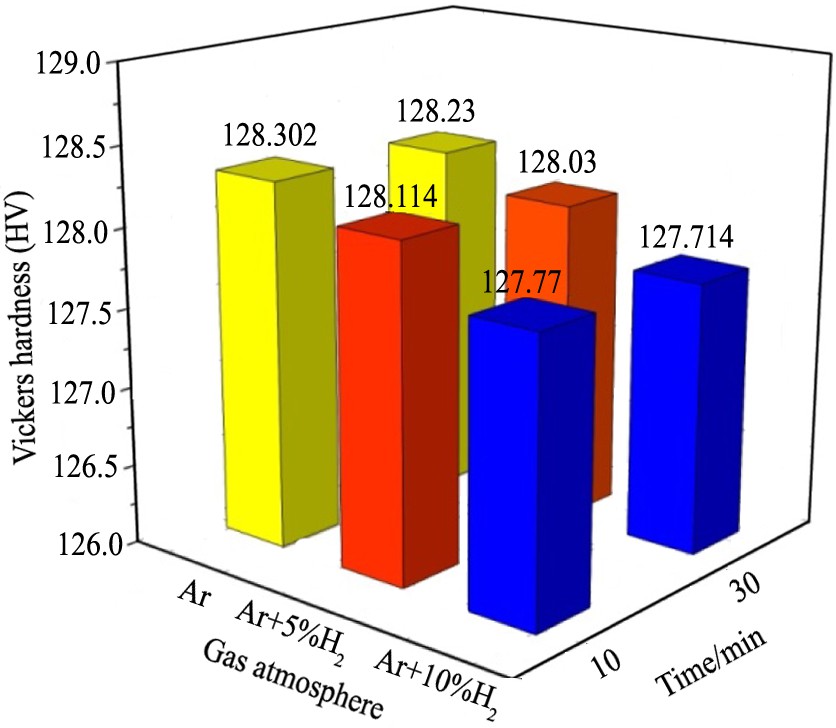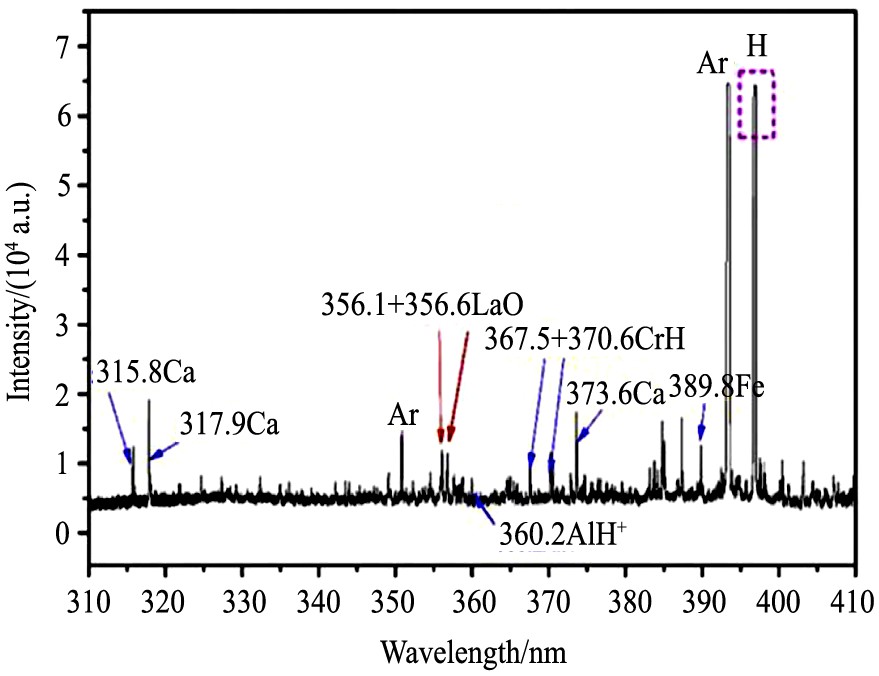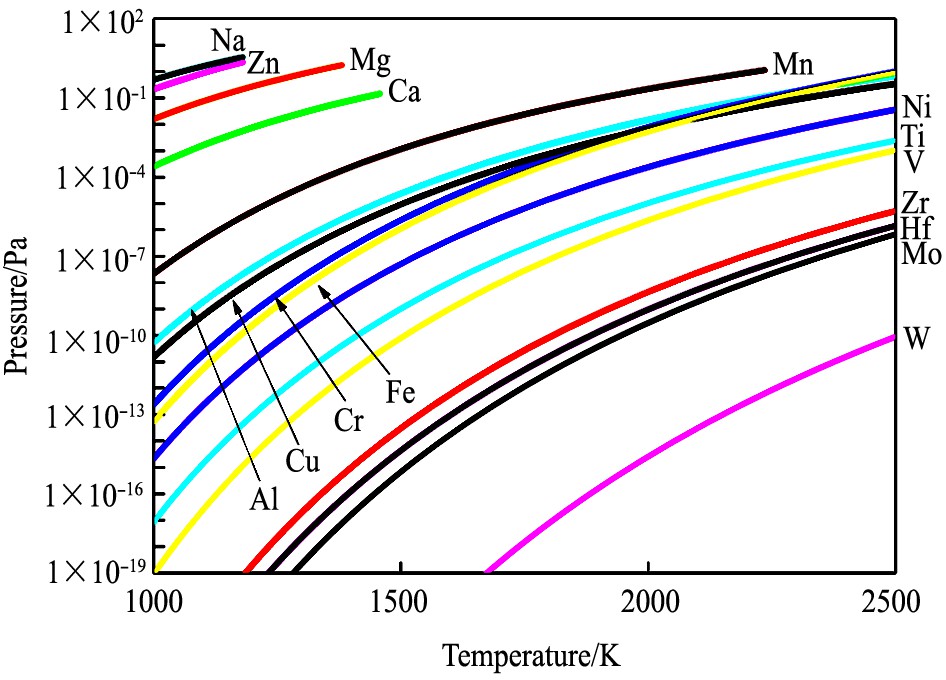网络首发时间: 2018-09-05 07:01
高熔点金属氢氩等离子弧纯化研究
沈阳工业大学材料科学与工程学院
哈尔滨工业大学材料科学与工程学院
摘 要:
高熔点金属在电子、化工、原子能、航空航天、武器装备等领域具有广泛应用, 但是都含有一定量的气体杂质元素、金属和非金属杂质元素, 以及各类物理“杂质” (晶体缺陷) 等, 这些杂质含量在达到一定浓度时对材料的物理与化学性能会产生很大的影响, 因此需要对高熔点金属进行有效提纯。采用Ar-H2等离子体电弧熔炼纯化高熔点金属Zr, 利用氢气较高的还原性以及电离态的氢原子具有极高的热导率来增强提纯效果, 并进行了成分和含量测定、元素蒸气压分析和硬度测量。结果表明, Ar-H2等离子体电弧熔炼能够有效提高高熔点金属Zr的纯度, 明显降低杂质元素的含量, 并且随着纯度的提高, 硬度逐渐降低, 符合金属越纯其硬度越小的原理。与未提纯金属Zr (纯度96.4%) 相比, 在熔炼10 min时, 纯氩气条件下样品纯度达到98.09%;通入5%氢气时, 样品最终纯度为98.18%;通入10%氢气时, 样品最终纯度为98.22%。在30 min时, 纯氩气条件下样品纯度达到98.12%; 5%氢气的样品纯度为98.21%; 10%氢气的样品纯度为98.23%。
关键词:
中图分类号: TF111
作者简介:何梦园 (1994-) , 男, 河南信阳人, 硕士, 研究方向:亚稳材料及其表征, E-mail:mengyuanhe1242@163.com;*董福宇, 副教授;电话:13109896829;E-mail:dongfuyu2002@163.com;
收稿日期:2018-07-21
基金:国家自然科学基金项目 (51404429);中国博士后科学基金 (2015M571327);辽宁省教育厅一般项目 (LGD2016018) 资助;
Purification of High Melting Point Metal by Hydrogen Argon Plasma Arc
He Mengyuan Dong Fuyu Zhang Yue Yuan Xiaoguang Luo Liangshun Su Yanqing
School of Materials Science and Engineering, Shenyang University of Technology
School of Materials Science and Engineering, Harbin University of Technology
Abstract:
High melting point metals are widely used in the fields of electronics, chemical industry, atomic energy, aerospace, weaponry, but they all contain a certain amount of gas impurity elements, metal and non-metallic impurity elements, as well as various physical “impurities” (crystal defects) , the content of these impurities in a certain concentration will have a great impact on the physical and chemical properties of the material, so it is necessary to effectively purify high melting point metals. In this paper, Ar-H2 plasma arc melting was used to purify the high melting point metal Zr. The purification effect was enhanced by the high reduction of hydrogen and the extremely high thermal conductivity of the hydrogen atoms in the ionization state, and the composition and content were determined. Element vapor pressure analysis and hardness measurement were completed. The results showed that Ar-H2 plasma arc melting could effectively improve the purity of high melting point metal Zr and decrease the content of impurity elements, and with the increase of purity, the hardness decreased gradually, which accorded with the principle that the more pure metal was, the smaller the hardness was. Compared with the unpurified metal Zr (96.4%) , the purity of the sample was 98.09% in pure argon, 98.18% in 5% hydrogen and 98.22% in 10% hydrogen, respectively. At 30 min, the purity of the sample reached 98.12% in pure argon gas. The purity of the sample in10% hydrogen was 98.21% and the purity of that in 5% hydrogen was 98.23%.
Keyword:
high-melting metal Zr; purification; Ar-H2 plasma; vapour pressure;
Received: 2018-07-21
高熔点金属, 又称难熔金属, 一般指熔点高于1650 ℃并有一定储量的金属。 这类金属具有低放气率、 良好耐冲蚀性、 高塑性、 高温蠕变性能等优点
目前, 传统的提纯方法
1 实 验
1.1 材料及设备
本实验的原料采用纯度为96.4%的高熔点金属Zr, 其杂质含量见表1所示。 实验是在高真空非自耗电弧熔炼炉提纯装置中进行的, 其结构图如图1所示。
提纯装置主要由真空熔炼装置、 机械控制装置、 电源控制装置、 循环水冷装置和混气装置组成。 真空熔炼装置的工作原理是在高真空条件下通过电弧产生高温使原料熔化。 机械控制装置主要是利用机械泵与分子泵控制炉内真空度。 电源控制装置可以将输入的交流电变换为直流电, 再将直流电变为可调节的电流, 输出给钨极, 从而达到不同的熔炼效果。 循环水冷装置主要是用来冷却坩埚和钨极, 避免高温损伤。 混气装置是将氢气与氩气分别通入BR100/2型气体混配器达到所需气体比例。
1.2 方 法
为了保证原料的清洁度, 避免二次污染, 将原料放入丙酮溶液清洗, 去除表面油污, 然后将原料放入JP-010T超声波清洗仪, 去除表面杂质, 最后高温烘干。
表1 高熔点金属Zr中的杂质含量
Table 1 Impurity content in high melting point metal Zr
Element |
Cr | Cu | Fe | Hf | Mg | Mn | Mo | Ni | Si | Ti | V | O | C | N |
Content/ (103×10-6) |
20 | 200 | 150 | 1760 | 60 | 10 | 0.35 | 10 | 20 | 50 | 0.4 | 5.5 | 1 | 0.17 |
图1 高真空非自耗电弧熔炼炉提纯装置示意图
Fig.1 Schematic diagram of purification device for high vacuum non-consumable arc smelting furnace
实验前循环水冷装置打开, 然后将将纯度为96.4%的高熔点金属Zr置于坩埚中, 关闭炉腔, 抽真空至6×10-3 Pa, 先通入纯氩气进行熔炼, 将所有原料熔成锭, 正反面各2次, 使混合均匀, 然后重新抽真空至6×10-3 Pa, 通入氢氩混合气 (纯Ar, 95%Ar+5%H2, 90%Ar+10%H2) , 以相同电流250 A熔炼相同时间 (10和30 min) , 得到纯化处理后的高熔点金属Zr试样。
通过Agilent725型电感耦合等离子体原子发射光谱仪 (ICP-OES) 与美国LECO公司的ROH600型氢氧测定仪分析提纯后金属与非金属纯度变化。 通过HVS-10Z型维式硬度计测量提纯后金属的硬度变化情况。
2 结果与讨论
2.1 实验结果
2.1.1 杂质去除
样品的提纯效果以杂质元素的去除率来表示, 去除率越大, 提纯效果越好, 单个杂质元素去除率的计算公式
RD= (Ci-Cf) /Ci×100% (1)
式中, Ci为该元素初始成分含量 (10-6) , Cf为该元素最终成分含量 (10-6) , RD (%) 为该元素去除率。
进一步研究等离子体熔炼对提纯的影响, 可以计算样品中多种杂质元素RD (%) 的平均值:
式中, m为杂质元素的数量。
(1) 金属元素的去除率
熔炼初始阶段, 高能量等离子体电弧使得金属Zr以极快的速度熔化, 原始样品内含有的大量杂质可迅速挥发, 因此可取得初步较好的纯化效果。 当纯氩气作为唯一的等离子体源时, 样品中主要杂质元素已有显著降低。 然而, 与纯氩气熔炼相比较, 当炉内通入氢氩混合气后, 氢等离子体电弧熔炼表现出更优的纯化效果。 以10 min为例, 纯氩气条件下熔炼的样品纯度达到98.09%; 95%Ar+5%H2混合气体条件下熔炼的样品最终纯度为98.18%; 90%Ar+10%H2混合气体条件下熔炼的样品纯度进一步提高, 纯度可达98.22%。 在 30 min时, 纯氩气条件下熔炼的样品纯度达到98.12%; 95%Ar+5%H2混合气体条件下熔炼的样品纯度为98.21%; 90%Ar+10%H2混合气体条件下熔炼的样品纯度为98.23%。 由上述结果可知, 两种氢含量下的提纯效果较相近, 产生的原因可能是当氢含量增加到10%时, 氢化锆纳米粒子将大量生成, 导致金属锆的蒸发失重增高, 从而降低了它的提纯效果。 此外, Li等
由表2可以发现Cr, Cu, Fe, Mg, Mn, Ni, Si, Ti等杂质元素的去除率随着氢含量和熔炼时间的增加而增大, Hf, Mo, V等杂质元素的去除率基本保持不变, 多种杂质元素的平均去除率也随着氢含量和熔炼时间增加而增大。 在Ar+10%H2条件下熔炼30 min时去除效果最好, 其平均值达到68.74%。
(2) 氧、 碳、 氮的去除率
由表3发现氧、 碳、 氮的去除率随熔炼时间和氢含量的增加而增大, 而且随着熔炼时间的延长, 去除率的增加趋势逐渐减缓。 在Ar+10%H2条件下熔炼30 min时去除效果最好, 其平均值达到88.05%。
2.1.2 Zr的硬度测量
为了进一步研究提纯效果对金属Zr的影响, 对Zr进行了硬度测试。 在无冲击和振动的的情况下施加压力, 保压10 s情况下进行测量。 通过维氏硬度计测量了5组硬度值, 并计算出了平均值, 结果如图2所示。 可以发现熔炼时间越长、 氢含量越高时, 硬度越低, 即提纯效果越好, 其硬度值越小, 符合金属越纯硬度越小的基本规律。
2.2 分析与讨论
熔炼时间越长、 氢含量越大, 杂质含量越低, 硬度越低, 金属Zr的纯度越高。 其纯化过程主要与温度和杂质元素蒸气压有关。
表2 不同熔炼气体氛围下金属Zr在250 A熔炼10和30 min后的去除率
Table 2 Removal rate of Zr smelting 10 and 30 min at 250 A under different smelting atmospheres (%)
| Condition | Cr | Cu | Fe | Hf | Mg | Mn | Mo | Ni | Si | Ti | V | RDav |
10 min+100%Ar |
59.0 | 93.40 | 20.67 | 2.28 | 95.83 | 48 | 14.29 | 61 | 57 | 50 | 38 | 49.04 |
30 min+100%Ar |
63.5 | 94.30 | 34.67 | 2.28 | 96.17 | 50 | 14.29 | 65 | 58.5 | 54 | 38 | 51.88 |
10 min+Ar+5%H2 |
72.0 | 97.05 | 69.33 | 1.70 | 98.00 | 77 | 14.29 | 71 | 64.5 | 74 | 25 | 60.35 |
30 min+Ar+5%H2 |
75.5 | 97.60 | 76.67 | 2.28 | 98.33 | 81 | 22.86 | 75 | 65.5 | 78 | 25 | 63.43 |
10 min+Ar+10%H2 |
84.5 | 98.60 | 82.00 | 2.28 | 99.50 | 90 | 22.86 | 76 | 71.5 | 80 | 38 | 67.75 |
30 min+Ar+10%H2 |
89.0 | 98.95 | 92.00 | 1.70 | 99.67 | 93 | 22.86 | 79 | 73.0 | 82 | 25 | 68.74 |
表3 不同熔炼气体氛围下氧、 碳、 氮在250 A熔炼10和30 min后的去除率
Table 3 Removal rate of O, C and N smelting 10 and 30 min at 250 A under different smelting atmospheres (%)
Condition |
O | C | N | RDav |
10 min+100%Ar |
83.87 | 56.6 | 57.06 | 49.04 |
30 min+100%Ar |
89.64 | 69.7 | 70.00 | 76.45 |
10 min+Ar+5%H2 |
89.80 | 70.2 | 66.47 | 75.49 |
30 min+Ar+5%H2 |
95.44 | 81.5 | 78.24 | 85.06 |
10 min+Ar+10%H2 |
90.95 | 71.3 | 75.29 | 79.18 |
30 min+Ar+10%H2 |
96.15 | 82.7 | 85.29 | 88.05 |
图2 氢含量和时间对Zr平均硬度的影响
Fig.2 Effect of hydrogen content and time on average hardness of Zr
2.2.1 纯化过程中氢等离子体的作用
氢等离子体电弧显著的提纯效果得益于在高电流密度下分解和激化了的氢原子。 当温度高于5000 K时, 氢气的电离达到95%以上, 电离产生的氢原子具有极高的导热率和化学反应活性
电离态的氢原子具有极高的热导率, 当氢等离子体电弧作用于熔融金属表面时可提高液相金属表面温度, 增大熔池中温度梯度。 一方面, 更高的温度梯度可促进基体中过饱和杂质通过热力学传输在液相中发生迁移。 另一方面, 杂质蒸气压随液相金属表面温度升高而升高, 进而促进了低蒸气压杂质元素的挥发脱除, 所以随着温度的升高, 杂质元素更容易挥发, 提纯效果越好。
为了进一步研究Ar-H2等离子体电弧纯化的机理, 由文献
H2→H++e- (3)
式 (4) 和 (5) 为金属内氧元素分别与氢分子和氢原子反应化学式, 式 (6) 和 (7) 为金属内氮元素分别与氢分子和原子反应化学式。 熔炼时电弧中电离态的氢原子具有比普通氢分子更高的化学反应活性, 髙温电弧环境更促进了氢与氧氮结合生成H2O和NH3, 氢等离子体在脱氧脱氮过程中发挥了更重要的作用。
O (in metal) +H2→H2O (4)
O (in metal) +2H→H2O (5)
N (in metal) +3/2H2→NH3 (6)
N (in metal) +3H→NH3 (7)
高温态电离产生的活性氢具有极强还原性, 可有效地脱除金属基体内的氧元素和氮元素, 同时也是消除金属表面氧化膜过程, 熔融金属表面氧化膜的脱除更有效促进内部杂质向外挥发。
2.2.2 杂质元素蒸气压对纯化效果的影响
在高温电弧熔炼密闭氛围中, 杂质金属元素从熔融基体金属内的挥发是杂质脱除的主要路径。 因此每种金属元素的蒸气压大小成为影响纯化效果的一个重要因素。 假设蒸发相变时, 在一定温度范围内, 蒸发焓对温度求导为常数, 根据Clausius-Clappeyron方程
图3 电弧光谱线
Fig.3 Arc spectral line
式中P为压力, T为温度, A, B, C, D为系数。 表4为几种元素的系数值。 图4为主要金属元素蒸气压随温度变化曲线。 由图4可知, 除去几类极易挥发的金属, Zr属于蒸气压较高的元素, 尤其在纯化过程中投料量较大, 需控制熔炼过程中基体金属的大量挥发。
杂质元素蒸气压越高, 其纯化后的残余量越少
表4 几种元素的系数值
Table 4 Coefficient values of several elements
Element |
A | B | C | D |
Cr |
6.8 | -20733 | 0.4391 | -0.4094 |
Cu |
9.123 | -17748 | -0.7317 | 0 |
Fe |
7.1 | -21723 | 0.4536 | -0.5846 |
Hf |
9.445 | -32482 | -0.6735 | 0 |
Mg |
8.489 | -7813 | -0.8253 | 0 |
Mn |
12.805 | -15097 | -1.7896 | 0 |
Mo |
11.529 | -34626 | -1.1331 | 0 |
Na |
5.298 | -5603 | 0 | 0 |
Ni |
10.557 | -22606 | -0.8717 | 0 |
Ti |
11.925 | -24991 | -1.3376 | 0 |
V |
9.744 | -27132 | -0.5501 | 0 |
W |
2.945 | -44094 | 1.3677 | 0 |
Zn |
6.102 | -6776 | 0 | 0 |
Zr |
10.008 | -31512 | -0.789 | 0 |
图4 主要金属元素蒸气压随温度变化曲线
Fig.4 Variation curves of vapor pressure of main metal elements with temperature
3 结 论
1. 采用Ar-H2等离子体电弧熔炼对金属Zr表现出较好的提纯效果, Cr, Cu, Fe, Mg, Mn, Ni, Si, Ti, O, C, N等杂质元素含量明显降低, Hf, Mo, V等元素含量几乎无变化。 在熔炼30 min, 通入10%氢气的样品效果最好, 纯度为98.23%, 其平均去除率为71.42%, 说明随着氢气含量和时间的增加, 脱除效果更明显。
2. 提纯效果主要与温度和杂质元素蒸气压有关。 氢氩等离子体电弧熔炼可提高液相金属表面温度, 增大熔池中温度梯度, 促进杂质元素的挥发脱除; 杂质元素蒸气压越高, 越容易脱除, 残余量降低。
3. 提纯效果越好, 其硬度值越小, 符合金属越纯硬度越小的基本规律。
参考文献






